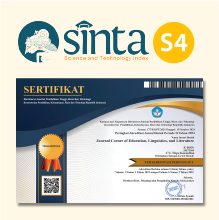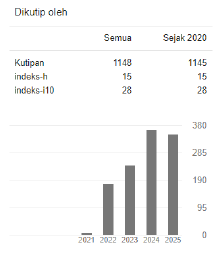Singing Method: Can It Improve the Early Childhoods’ Language Skills?
 https://doi.org/10.54012/jcell.v3i3.273
https://doi.org/10.54012/jcell.v3i3.273
 Abstract views: 391
Abstract views: 391
 PDF downloads: 315
PDF downloads: 315
Keywords:
early childhood education, early childhoods, language skills, singing methodAbstract
Mastering language earlier for early childhoods is very urgent. It is because through language early childhoods can express their thoughts easier to their parents, teachers, and people around them. Through language, early childhoods are also able to learn five other basic abilities, such as: (1) religious and moral values, (2) physical-motor, (3) cognitive, (4) social-emotional, and (5) art. This study aims to analyze the effect of using singing method applied to the early childhoods aged 5-6 years. To acquire the data, the researchers employed qualitative method under a descriptive approach. Based on the observation, the data showed that singing method applied by the teachers at school and also applied by the parents at home become an effective method to enhance the early childhoods’ language skills, such as: (1) helping them to have self-confidence, (2) helping them to be able to memorize the lyrics of the song, (3) helping them to be able to enhance the new vocabulary, and (4) helping them to be able to understand the meaning of the new words. In conclusion, the use of singing method is effective to develop the early childhoods’ language skills.
Downloads
References
Amalia, D. P. M., Yetti, E., & Sumadi, T. (2022). Motions and songs to improve basic literacy through animation videos. JPUD - Jurnal Pendidikan Usia Dini, 16(2), 224–239. https://doi.org/10.21009/JPUD.162.03
Fadlillah, M. (2016). Design pembelajaran PAUD. Jogjakarta: Penerbit Ar-Ruzz Media.
Hidayat, R. (2023). Kebijakan asesmen kompetensi madrasah Indonesia (AKMI) pada satuan madrasah ibtidaiyah. Jurnal Intisabi, 1(1), 1–9. https://doi.org/10.61580/itsb.v1i1.1
Hidayat, Y., Herniawati, A., & Ihsanda, N. (2022). The use of drilling technique to teach English speaking to the early childhoods: A descriptive study. Journal Corner of Education, Linguistics, and Literature, 2(1), 73–80. https://doi.org/10.54012/jcell.v2i1.66
Hidayat, Y., Nurhayati, I., Salamah, S., Rosmiati, M., Fatimah, A. S., & Lastari, L. (2023). Effect of the educational game tools on early childhoods in the kindergarten. Journal Corner of Education, Linguistics, and Literature, 3(2), 100–107. https://doi.org/10.54012/jcell.v3i2.200
Hidayat, Y., & Nurlatifah, L. (2023). Analisiskomparasi tingkat pencapaian perkembangan anak usia dini (STPPA) berdasarkan permendikbud no. 137 tahun 2014 dengan permendikbudristek No. 5 Tahun 2022. Jurnal Intisabi, 1(1), 29–40. https://doi.org/10.61580/itsb.v1i1.4
Hidayat, Y., Susanti, V., Muztahidah, D., Hajar, S., & Muslihat, A. S. (2023). Analisis penggunaan media big book dalam mengembangkan kemampuan berbahasa anak usia 3-4 tahun. Al-Urwatul Wutsqo: Jurnal Ilmu Keislaman Dan Pendidikan, 4(2), 40–45. https://doi.org/10.1234/al-urwatul%20wutsqo.v4i2.75
Khairani, N., Siregar, R., & Lubis, J. N. (2023). Penerapan metode bermain peran dalam meningkatkan perkembangan bahasa anak. Jurnal Obsesi: Jurnal Pendidikan Anak Usia Dini, 7(5), 5942–5952. https://doi.org/10.31004/obsesi.v7i5.5383
Mardiah, L. Y., & Ismet, S. (2021). Implementasi metode bernyanyi dalam mengembangkan kemampuan berbicara anak usia 4-6 tahun. Jurnal Pendidikan Tambusai, 5(1), 402–408. https://doi.org/10.31004/jptam.v5i1.962
Mulyono, N., Herniawati, A., & Hidayat, Y. (2023). Bedtime Storytelling: A Method to Enhance Early Childhoods’ Language Development. Jurnal Pendidikan Anak Usia Dini Undiksha, 11(3), 61–69. https://doi.org/10.23887/paud .v10i3
Nugraheni, T., & Suparno, S. (2023). Pengaruh profil guru PAUD terhadap penguasaan STPPA. Jurnal Obsesi: Jurnal Pendidikan Anak Usia Dini, 7(4), 4119–4127. https://doi.org/10.31004/obsesi.v7i4.5040
Ratno, R. (2021). Improving children verbal language competence through story telling used visual audio media. ThufuLA: Jurnal Inovasi Pendidikan Guru Raudhatul Athfal, 9(1), 1–16. https://doi.org/10.21043/thufula.v9i1.8781
Ridwan, R., & Awaluddin, A. F. (2019). Penerapan metode bernyanyi dalam meningkatkan penguasaan mufradat dalam pembelajaran bahasa Arab di raodhatul athfal. DIDAKTIKA: Jurnal Kependidikan, 13(1), 56–67. https://doi.org/10.30863/didaktika.v13i1.252
Sugiyono, S. (2013). Metode penelitian kuantitatif, kualitatif, dan R&D. Bandung: Penerbit Alfabeta.
Susilawati, S. (2014). Penerapan metoda bernyanyi dalam meningkatkan kecerdasan berbahasa pada pendidikan anak usia dini (Studi deskriptif tentang penerapan metoda bernyanyi di PAUD Al Azhar Syfa Budi Parahyangan). 4(2), 141–151. https://doi.org/10.22460/empowerment.v3i2p141-151.581
Wahyuningsih, S., Nafisah, P., Mulyono, N., & Hidayat, Y. (2023). Utilization of SQ3R Method to Enhance English Reading Skills: Students’ Voices in The Indonesian Higher Education Context. International Journal Corner of Educational Research, 2(1), 17–22. https://doi.org/10.54012/ijcer.v2i1.175
Yul, S., Mafardi, Novela, T., Anggraini, V., & Priyanto, A. (2023). Stimulating children’s numerical literacy: The effectiveness of singing favorite food songs. JPUD - Jurnal Pendidikan Usia Dini, 17(1), 144–154. https://doi.org/10.21009/JPUD.171.11
Downloads
Published
How to Cite
Issue
Section
License
Copyright (c) 2024 Rahmat Hidayat, Ulfah Tunajijah, Siti Ernasari, Elis Susanti, Lulu Muhimah, Mia Rosmiati, Lia Nurliani

This work is licensed under a Creative Commons Attribution-ShareAlike 4.0 International License.
All articles published in the Journal Corner of Education, Linguistics, and Literature are licensed under the Creative Commons Attribution-ShareAlike License (CC BY-SA).

















